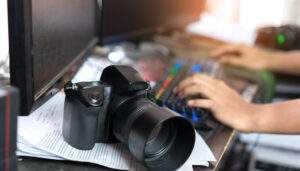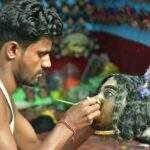Storytelling, elegance, and inventiveness have long been central to fashion photography. But in 2025, accountability and creativity are equally important. The fashion industry is embracing the realm of digital fashion and shifting toward more sustainable methods both globally and in India. Training in photography is, of course, also changing.
The curricula of fashion photography courses today change greatly from those of a few years ago, if you’re thinking about taking one. Institutions are now offering courses on digital technology and sustainability in addition to traditional skills like lighting, posing, and post-production. The upcoming generation of photographers is being shaped by these shifts into professionals who are not just technically proficient but also socially concerned and prepared for the future.
Why the Shift in Fashion Photography Training?
This transformation is being driven by two main forces:
- Sustainability Concerns
- One of the most polluting businesses in the world is fashion. High carbon footprints, wasteful shooting, and fast fashion are all closely monitored.
- Eco-friendly campaigns are now being demanded by brands, particularly in India, for everything from the fabrics used to the methods utilized for picture shoots.
- One of the most polluting businesses in the world is fashion. High carbon footprints, wasteful shooting, and fast fashion are all closely monitored.
- The Rise of Digital Fashion
- Virtual fashion shows, 3D modeling, and digital apparel are no longer experimental niches. By 2025, they will be widely available in regions like the US, Europe, and increasingly India.
- In order to bring virtual clothing to life, photographers now need to learn how to work with CGI designers in addition to shooting actual apparel.
- Virtual fashion shows, 3D modeling, and digital apparel are no longer experimental niches. By 2025, they will be widely available in regions like the US, Europe, and increasingly India.
The Traditional Foundation Still Matters
It’s important to note that a fashion photography school still develops upon classic foundations before delving into the latest trends. The first lesson for aspiring photographers:
- Studio Lighting — merging of natural light, low-key, and high-key
- Posing Models — directing fashion shows, advertisements, and editorials
- Camera Skills — Using medium format, mirrorless, and DSLR cameras
- Styling & Collaboration — collaborating with stylists, makeup artists, and designers
- Post-Production — Using Capture One, Lightroom, and Photoshop for editing
These ageless abilities continue to be the foundation. However, in order to prepare photographers for the future, sustainability and digital fashion are now being added on top.
Sustainability in Fashion Photography Courses
1. Eco-Friendly Shoot Practices
Students are learning from institutes how to organize picture shoots with the least amount of waste:
- Using natural light rather than setups that use a lot of energy.
- Avoiding single-use plastics in favor of reusable props.
- Choosing outdoor settings or environmentally friendly backgrounds.
2. Sustainable Fashion Awareness
Photographers are encouraged to learn about production techniques and textiles. In order to help photographers match their campaigns with environmentally sensitive narrative, several courses now feature guest lectures from sustainable designers in India.
3. Carbon Footprint Awareness
Students receive instruction on how to compute and lessen their shoots’ carbon footprint. For instance:
- Combining the transportation of equipment.
- Utilizing local talent to cut down on overseas trips.
- Utilizing hybrid shoots, which combine digital and physical elements, in order to save resource consumption.
4. Promoting Local & Ethical Brands
In India, fashion photographers are also trained to work with small sustainable labels, weavers, and craftspeople. In addition to boosting regional economy, this produces genuine advertising efforts.
The Digital Fashion Revolution
1. Virtual Clothing Photography
3D fashion tools like Clo3D and Marvelous Designer are increasingly taught in fashion photography courses. After learning how to take green screen photos of models, students work with computer-generated imagery (CGI) artists to “dress” them in virtual clothing.
2. AR & VR in Fashion Campaigns
Photographers are taught to take pictures for VR fashion presentations or augmented reality filters. For instance, a company introducing a new line of sarees could want an augmented reality filter that allows customers to “try on” the garment virtually.
3. NFT & Digital Artwork Creation
A large number of fashion photographers are marketing their work as NFTs in 2025. Modules on copyright, digital ownership, and producing superior NFT fashion art are now included in the courses.
4. Hybrid Shoots
Traditional photo shootings are still relevant in the age of digital fashion. Rather, hybrid projects are becoming more popular:
- Studios are used to shoot models.
- Later, clothing is digitally superimposed.
- This keeps human emotion in the forefront while reducing the manufacture of clothing.
How Indian Institutes Are Adapting
Fashion capitals such as Delhi, Mumbai, Bangalore, and Kolkata are leading the way in these developments. In India, a contemporary fashion photography course currently provides:
- Working with eco-friendly designers, these workshops focus on sustainable styling.
- Practical knowledge of 3D fashion tools.
- Partnerships with fashion tech entrepreneurs, AR fashion try-ons have been more popular in India.
- Students are exposed to the real world through live initiatives with ethical brands.
For instance, a student from Kolkata might film a commercial for a regional handloom saree company that encourages environmentally friendly weaving. For diversity, the campaign may combine authentic sarees with digitally improved versions rather than producing hundreds of genuine costumes.
Skills Every Fashion Photographer Needs in 2025
Here’s what you’ll learn beyond the fundamentals if you’re serious about going into this field:
- Lighting for Sustainable Shoots — with eco-friendly configurations.
- Editing for Digital Fashion — perfectly fusing virtual and real clothes.
- Storytelling with Responsibility — demonstrating inclusion, ethics, and diversity.
- Tech-Savviness — working along with AR developers, NFT platforms, and CGI artists.
- Cultural Sensitivity — particularly significant in India, where tradition and fashion are closely intertwined.
Benefits of Embracing These Trends
For Students
- Keep one step ahead of the competition.
- Collaborate with progressive companies.
- Create a portfolio that appeals to people everywhere.
For India’s Fashion Industry
- Greener promotions cut down on waste.
- Presenting Indian handmade customs in contemporary digital formats.
- Establishing India as a pioneer in environmentally friendly fashion photography.
Challenges Students Face
It’s not all smooth, of course. There are obstacles to learning these new methods:
- Technology Access: Not all students can afford expensive 3D modeling systems.
- Skill Gaps: Mutual understanding is necessary for photographers and CGI artists to collaborate.
- Market Acceptance: Although this is improving, some Indian clientele still like conventional shots.
Industry partnerships, labs with cutting-edge software, and projects that expose students to a variety of environments are ways that good institutions close this gap.
Choosing the Right Fashion Photography Course in 2025
When choosing a course, inquire:
- Are there any modules on digital fashion and sustainability included?
- Are there ongoing initiatives involving digital-first or eco-friendly brands?
- Do they grant access to post-production labs and 3D design tools?
- Are trainers professionals with experience in fashion technology?
- Do graduates have a portfolio that includes both digital and conventional work?
An institution is considered future-ready if it responds “yes” to the majority of these questions.
A Day in a Sustainable/Digital Fashion Photography Course
Here is an example of what a normal training day would entail in 2025 to give you an idea:
- Morning: Talk about environmentally friendly fashion with a sustainable designer.
- Afternoon: Studio session with little props and natural light sets.
- Evening: Students digitally superimpose their attire on the morning’s images during the Clo3D workshop.
- Wrap-up: Feedback session on the integration of digital storytelling and sustainability.
Students are well-prepared for the real fashion industry by this blend of creativity, technology, and responsibility.
Conclusion
The field of fashion photography is rapidly changing. Being a proficient photographer in 2025 entails being a digital inventor and a conscientious creator in addition to being a visual artist. In addition to teaching you how to take beautiful pictures, a quality fashion photography course will teach you how to shoot ethically and embrace cutting-edge styles like digital fashion.
This presents both a problem and an opportunity for Indian students. Indian photographers are in a unique position to spearhead this worldwide transformation because of our rich textile legacy and thriving digital industry.
Look beyond camera and editing skills if you intend to enroll in a fashion photography program this year. Select a course that will equip you for the future of sustainable, digitally-first fashion.
Because the future of fashion depends on how responsibly and artistically it is portrayed, not just how it looks.











